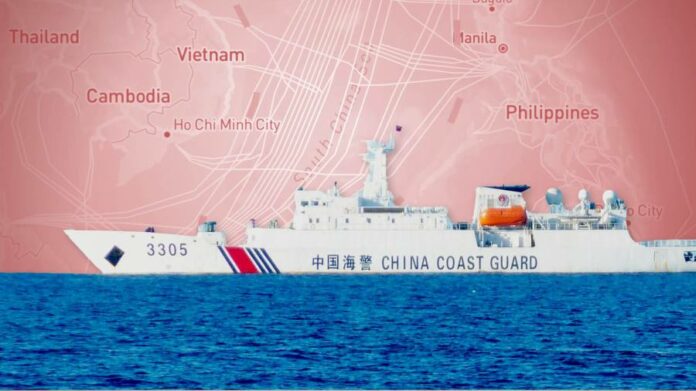China has begun to impede projects to lay and maintain subsea internet cables through the South China Sea, as Beijing seeks to exert more control over the infrastructure transmitting the world’s data.
Long approval delays and stricter Chinese requirements, including permits for work conducted outside its internationally recognised territorial waters, have pushed companies to design routes that avoid the South China Sea, according to multiple sources inside the industry.
A cable under construction called SJC2, which will connect Japan to Singapore as well as Taiwan and Hong Kong, has been delayed by more than a year because of Chinese objections and lengthy permit issues, according to two industry executives.
China held up approval for sea-floor prospecting for the cable — owned by a consortium including China Mobile, Chunghwa Telecom and Meta — for several months in its territorial waters around Hong Kong. The authorities cited concerns that the contractor might conduct spying or install extraneous equipment, according to one person directly involved in the project who requested anonymity.
“China is attempting to exert more control over undersea activities in its region, in part to prevent US surveillance systems from being installed as part of undersea cable deployment,” said Bryan Clark, a former US submarine officer and senior Navy official.
“The Chinese government also wants to know exactly where civilian undersea infrastructure is installed for its own mapping purposes,” added Clark, who is now at the Hudson Institute think-tank.
Tensions over who owns, builds and runs the fibre cables sending internet traffic around the world have risen sharply since 2020, when the US government began to block Chinese involvement in international consortium projects. Washington has also denied permission for subsea cables connecting the US to mainland China and Hong Kong.
Several industry sources said China’s policing of its waters — including within maritime areas marked on maps by a disputed “nine-dash line” — is a response to Beijing being excluded from international projects and fears that companies could use cables as a front for espionage.
According to international law, states or companies laying and maintaining internet cables require government permits for access to the seabed within 12 nautical miles of a country’s territory. But permission is not typically required in waters anywhere between 12 nautical miles and 200 nautical miles from land, known as a state’s “exclusive economic zone”.
Chinese authorities have made the process for obtaining permits within the 12-mile stretch long and onerous, according to three industry executives with direct knowledge of the situation.
China is also among a handful of countries in Asia that have started requesting permits for cable-laying in claimed territorial waters beyond 12 miles, in apparent contravention of international maritime law, according to executives at two major subsea cable companies in Europe and two lawyers working with companies in the region.

Beijing claims the South China Sea in almost its entirety and frequently disrupts rival claimants’ use of it for oil exploration and fishing.
“The edict from the [Chinese Communist party], passed down by local government representatives, is that you need a permit in their EEZ,” said one subsea cable executive. “The last thing you want is to approach Chinese waters and a gun boat comes out and stops you. It’s just really murky out there [and] the cost of not doing it means that people fold and apply [for permits].”
Requiring permits for cable work gives China oversight and influence over the entities that control the metal-encased fibre lines carrying data around Asia. It also gives Beijing leverage to demand a seat at the table for infrastructure projects by requesting that its companies, ships or personnel are involved.
The South China Sea is a popular subsea cable route, offering the most efficient path to connecting east Asia with the south and west of the continent, as well as onwards to Africa.
About 95 per cent of all intercontinental internet traffic — data, video calls, instant messages and emails — is transmitted via more than 400 active submarine cables that extend for 1.4mn km.
Clark said China’s requirements were “not consistent” with the UN Convention on the Law of the Sea, noting that its permitting requirements stretched far beyond its EEZ to encompass almost all of the South China Sea. “Much of this area is actually the EEZ of China’s neighbours,” he added.
The Chinese Ministry of Natural Resources and ministry of defence did not respond to a request for comment.
Several sources said that to avoid deadlock over permits, subsea cable consortiums were now seeking to forge new routes that circumvent China’s claimed waters.
Two cables under construction, called Apricot and Echo, will transport data from Singapore to Japan and the US, respectively, avoiding the South China Sea by circling around Indonesia.
“Nobody is daring to do operations without explicit authorisation . . . that never comes,” said a European subsea cable executive. Other projects under procurement would avoid the area because of these issues, he added.
The cost of contracting boats for cable-laying and maintenance can be about $100,000 a day, making companies reluctant to risk any action that could be blocked or sabotaged.
Avoiding waters claimed by China was a “double punishment”, the executive said, because it is more expensive to lay cable along the new route as the shallower waters near Borneo require extra layers of armour around the fibre.
“It means building is longer and costs more,” said a Singapore-based executive for a global technology company. “It is digital infrastructure decoupling.”







